Ushers to Ashes Podcast
Recipe By: Michael Laub/Remote Control productions
Serving Size: 5 000
Preparation Time: 36 months
Amount Measure Ingredient
________________________________________
1 ounce Orientalism
1 ounce Condescension
3 ounces Teutonic Cool (or to fill)
1 ounce American Bluff
Preparation Method
Fill an auditorium full of middle-class culture vultures; blend with classical Indian dance, selective Bollywood film conventions, postmodern irony and canonical German literature. Mix with a multicultural performing group. Add a sprinkle of orientalism, and stir for 21/2 hours. Makes a good excuse to be in the vicinity of the world famous speigaltent.
* * *
Total Masala Slammer confounded my expectations. Perhaps I took its title too literally. I expected a heady blend of hot Indian spices, with the intoxicating wallop of a potent alcoholic beverage. What I got was a rather tame melange of pre-packaged Pataks and a Claytons cocktail. But maybe I was expecting too much.
The first thing that surprised me about the performance was its scale. Rather than present the audience with a cluttered space filled with the trappings of what we have come to expect from global blockbuster performances (extravagant light shows, manifold television screens, intricate sets), Laub and his company opted for an open space with relatively little ornamentation (at least in comparison to some of the other festival productions such as Gensi). The only concession to large-scale spectacle was the different coloured curtains that provided the backdrop for the performance (every so often a curtain would crash to the ground revealing another curtain of a different hue in its wake — the united colours of Remote Control productions?). With the exception of a single projection screen supported by scaffolding, and a few strategically placed chairs and microphones, the space was designed to accommodate the expansive dance sequences.
The performance began with one of the two American male dancer/actors addressing the audience directly, and explaining that the ensemble would quote from Goethe’s text from time to time in a pretty casual, offhanded way (he fingered a dog-eared copy of Young Werther to emphasise the point). What followed was indeed a masala slammer of sorts, for the company juxtaposed a few extracts from a Bollywood film, with classical Indian music and dance (Kathak), various bits of text delivered in English and German, audition videos from India for what I presume was the production in front of us, recitations and dramatisations of Goethe’s tragic, if somewhat sentimental, tale of unrequited love and a highly ironic Bollywood soap opera.
In many ways, the individual components of the performance worked well in themselves. The classical Indian dancers and musicians were particularly compelling. The western performers were charming, disarming in a sly, knowing way and overtly erotic. The Bollywood soap opera was vaguely amusing, but its one joke grew pretty thin with repetition. In any case, I’m not convinced that its possible to equate Bollywood histrionics with ‘bad acting. The company performed the extracts from Goethe’s The Sorrows of Young Werther with a heavy dose of irony to fine comic effect, highlighting the similarities between Goethe’s celebrated work and Bollywood soap.
However, while the performance effectively integrated the vocabularies of several different art forms — film, dance, theatre, music, and drama — it did not surmount the cultural and political divisions between east and west convincingly. For example, Bollywood dance sequences are supposed to be erotic — they must convey sexual relationships without resorting to representing any kind of sexual act forbidden by India’s strict censorship codes. Eroticism marked the performances of the westerners in the cast, whose dance vocabulary consisted of various bumps, grinds and shimmies — one female performer disrobed completely. In contrast, the Indian dancers, particularly the females, were demure, and with one exception covered. Of course, it’s possible to argue the toss about whether the performance of the Indian dancers was actually all the more erotic for its modesty, precision and focus. However, my point is that the energy and overt eroticism of Bollywood dance was present in the Western performers, and almost totally absent in the Indians. At times, I felt as though the Indians were ciphers for a familiar orientalist trope — the exotic, passive, feminised other.
I was also disturbed by the sequences where one of the white females donned headphones in order to reproduce the musical cadences of Indian speech patterns. Now I’m aware the performance as a whole appeared to play with different ethnic accents to highlight their musicality and relationship to movement, but the somewhat cheesy simulacra of Indian speech invoked, for me, the questionable racial stereotypes found in old British sit-coms like Mind Your Language, On the Buses and Curry and Chips.
What is perhaps more disturbing, though, is the fact that for the most part the western and eastern elements did not engage in an equal dialogue. In fact the eastern and western performers rarely interacted. Ultimately, Laub and his charges enlist Indian classical and popular culture to serve a production that never really delivers on its promise to serve a total masala slammer. The shit just didn’t mix.
Truckload of Sky: The Lost Songs of David McComb Vol. 1
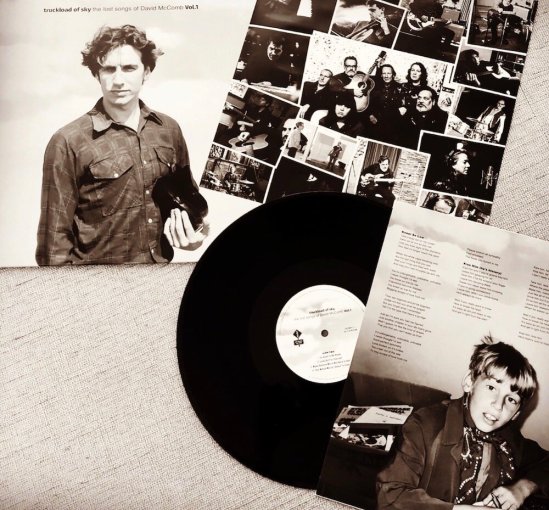
In 1988, you could buy a car for $100. That is, if you lived in Perth and, like me, had friends in low places (well, I had one friend who travelled the low road, if you know what I mean). Anyway, I knew the bomb was trouble, it was unregistered for starters. My mate told me that much at least.
A big, green gas guzzling monster, it’s best feature was a working cassette player, which I flogged to death by playing Calenture until the BASF tape snapped. The car gave up the ghost towards the end of that summer. It was heap (as in ‘heap of shit’)— I had to top up the leaky radiator every 5 or 6 kilometres, so no trips down south. One day, I pushed the beast too far and it shuddered to a halt just as I pulled into a parking space outside my flat in Highgate, huge plumes of grey smoke pouring out of the engine to the strains of ‘Vagabond Holes’. That was that. I left Perth for good a few weeks later.
The car and Calenture remind me of the last summer I spent in Perth as a resident. It was a typical Perth summer: in other words, fucking hot! Day after day, the temperature hovered around 40 degrees, or so it seemed. Despite the heat and my precarious mode of transportation, life was looking pretty good. I was in love and I was about to head ‘over east’ to take up a new job and start a new chapter in my life. Ah, so much promise. Needless to say, everything turned to shit — I lost the girl, I lost the job, and I lost my mind (until the wheel of fortune turned things around, temporarily —we’re all on borrowed time, folks).
Anyway, today, hearing a song like ‘Hometown Farewell Kiss’ takes me back to that remote period of time. I can’t listen to Calenture without feeling as though I’m being haunted by ghosts. Some of these spirits I’d rather forget, but others, like David McComb, the long-dead lead singer of The Triffids, remind me of how cool things once were for me as a young man. How brilliant it felt to cruise down to Fremantle on Stirling Highway, winding around the Swan river under the expansive canopy of Perth’s bright blue sky. Windows down, stereo blasting, summer breeze blowing through my hair. Good company, wild parties, great music, lost time. Nothing evokes this happy period more than the sound of David McComb’s voice, which featured heavily on the soundtrack of my life in the 1980s.
So, I was thrilled to hear that some of McComb’s collaborators and admirers were releasing an album, Truckload of Sky: The Lost songs of David McComb, comprised of some of his more obscure compositions (mostly drawn from his final decade, I think). The album does not disappoint. And even though we don’t hear his voice on this remarkable set of recordings, McComb’s spirit manifests in every track. The album is spooky, but in a good way. The ghost, as the late Niall Lucy, one of McComb’s old friends, might have told us, is a curious entity. It’s neither present or absent, material or immaterial. The ghost fucks with time by putting it out of joint by erasing clear distinctions between past, present and future. The ghost might also make demands on the living to remember what has passed and why. Sometimes, they might issue an imperative to seek justice on their behalf (like literature’s most famous ghost, King Hamlet). Anyway, as I listen to Truckload of Sky, I can’t help thinking that the musicians on the album are seeking justice for McComb, for he deserves a much wider audience; he was, after all, one of the greatest songwriters to smudge the air with song and his relative neglect by the musi buying public is criminal.
The album begins with a trilogy of bitter love songs. ‘Kneel So Low’ is a sequel of sorts. Lyrically it evokes ‘The Seabirds’, the opening track from Born Sandy Devotional, in its nautical imagery and its ‘cold opening’, but whereas the older song conjures the utter desolation of rejection, the narrator of ‘Kneel So Low’ rebukes his Ex for changing her mind —it’s too late, baby, “I’m the type that bears a grudge.” Yet, he acknowledges that things are complicated. She is after all “unforgettable, unlovable, unliveable” (a bit like the girl who used to ride in my big green automobile). I love the cutting lead guitar tone on this track, which supports the song’s sentiment perfectly. ‘Kiss Him (He’s History)’ is a bit like emotionally sadistic Femme Fatale’s playbook — the twist is that the song is narrated by a victim of heartbreak. Do you really want to know how to hurt someone? Well, this is how you can inflict the maximum degree of pain: make the courtship unforgettable, get close and intimate, and when he’s under your spell, drive the knife home. Rob Snarski delivers a beautifully nuanced performance on this track — his phrasing serves the song perfectly. It’s simultaneously dramatic and lush. Snarski is another artist who merits much wider recognition (it’s easy to understand why Snarski was one of McComb’s favourite singers). Angie Hart’s unmistakable Aussie drawl gives a compelling reading of ‘Second Nature’ — another song about people hurting each other despite their best intentions —that fucking wheel of fortune won’t stop turning.
The next batch of songs are much darker. If anyone is capable of ventriloquising McComb, it’s J.P. Shilo — his tone, timbre and phrasing make him sound uncannily like the author of ‘Lucky for Some’. This is not to diminish Shilo’s talent in any way. The man is no mere copyist and he is magnificent on this particular song, which, as I read it, is a missive from a dying man. This song is truly haunting with its narrator staring up at a ceiling fan from his hospital bed while ruminating on how fickle life can be. Structurally, the lyrics are reminiscent of Leonard Cohen’s ‘Who by Fire’ — the pensive narrator reels off a list of the ways some people get fucked up while others seemingly glide through life— “some get branded/some get hung/some keep their hands clean/lucky for some” — did I mention that ruminations on the vicissitudes of fortune appear in several of this album’s songs? Well, they do. The song also reminds of Skip James’ harrowing ‘Washington D.C. Hospital Center Blues’ —another, spooky, dark song about illness and mortality. Shilo’s howl is as unsettling as Skip James’ falsetto. For me, this is the album’s highlight.
‘So Good to be Home’, sung by Snarski, takes me right back to 1988 and puts me in that fucking green car with ‘Hometown Farewell Kiss’ on the cassette player. However, the song is very different in sentiment and tone from what might appear to be its counterpart on Calenture. On one level, it’s about a prodigal son flying back home after a long absence. As the lead singer in a travelling band, McComb must have viewed his home town from the vantage point of a plane more times than most, yet there is something unsettling about this homecoming. I don’t think it’s a simple paean to Perth (despite the references to neat lawns and the river). It’s more like ‘The Green, Green Grass of Home’ or ‘Long Black Limousine’ — I get the feeling that the song is more about the yearning for home, or the comfort that the idea or memory of home might offer in a time of crisis (it’s hard not to read these lyrics in the light of McComb’s untimely death). Snarski, again, turns in a flawless performance. Indeed, there’s something in the singer’s voice that conjures this spectral reading: I can almost hear the traces of lost time. Time is definitely out of joint here.
‘Look Out for Yourself’ is sung from a desolate, lonely place: it poses the question: who can you turn to in your darkest hour? Well, the answer my friends doesn’t provide much comfort, for we are condemned, it seems, to face the final curtain by ourselves, hence, the imperative: look out for yourself. Bleak stuff, delivered with fortitude and a hint of swaggering bravado by Romy Vager. And as if things weren’t bad enough, the next track, ‘Make Believe We’re Not Here in Hell’, is about denying the reality of dire circumstances. This is another one of those ghostly time-travel songs, for me, at least (since the act of listening will open different portals in time for every listener). Anyway, I can hear the rumble of that green car as I listen to this track, which reminds me of my favourite song on Calenture, ‘Blinded by the Hour’ (the connection is not literal — both songs seem to be about bad faith and self-delusion). Where do we flee when we are fucked up? It seems that the gospel according to McComb exhorts us to take refuge in the imagination: ‘Maybe it’s time to make believe/And to sing these songs/If it stops the pain/But I don’t mind/And I won’t tell/If we make believe we’re not here in hell’.
The final song on the vinyl album is ‘This Whole World’s About to Slide’. Prescient or what? Remember that big blue canopy of sky I mentioned earlier? Well, the haunted narrator of this number needs a ‘truckload of sky’ to hold him down. Simon Breed nails this complex lyric with its emotional twists: ‘So tell me, just how lucky I got?’. Not very is the obvious response if one pays heed to the suspicious minds and chattering spooks that work their way through this track, sonically and lyrically. This song has grandeur and gravity and is a fitting finale to this extraordinary record. If you buy the CD version of the album, you get 3 bonus tracks, which come from McComb’s teenage years. The musicians really make these songs shine and they remind us just how precocious a talent McComb was even at a tender age. If ever a ghost deserved justice, it’s David McComb. I can’t wait for volume 2.
The Performing Garage, Friday 4th May
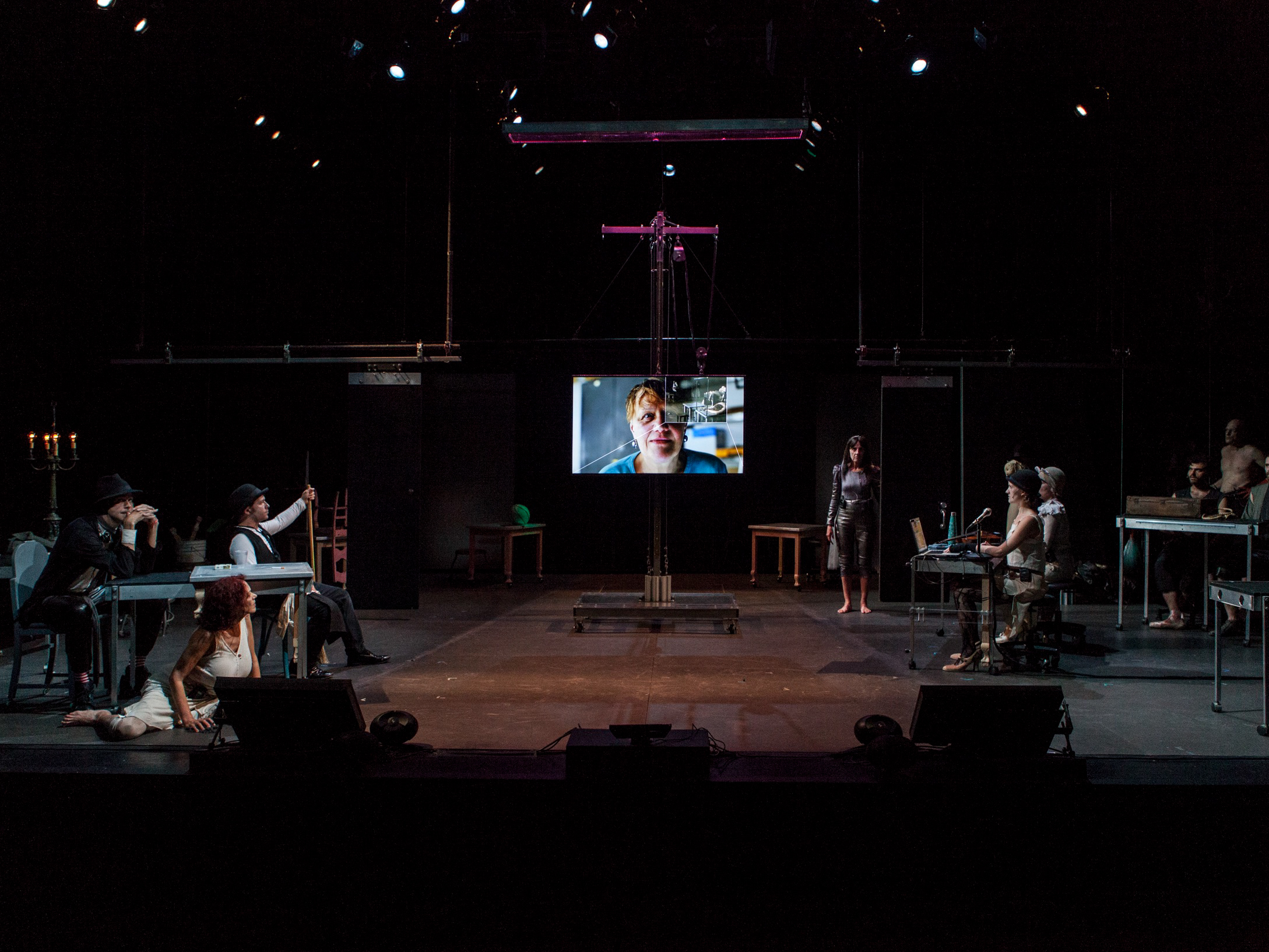
Here’s the premise:
“In A PINK CHAIR (In Place of a Fake Antique), The Wooster Group takes on one of the greatest figures in 20th century avant-garde theater: the iconic Polish stage director Tadeusz Kantor (1915-1990). Joining the Group as our guide and dramaturge is Kantor’s only daughter, Dorota Krakowska. Together, we will explore Kantor’s penultimate production, I Shall Never Return, and through it, his lifelong obsession with the myth of the return of Odysseus.”
A super-slick exercise in obscurity and navel gazing. I love this company, but this was not one of its best works.
Samuel J. Friedman Theatre, Thursday 10th May
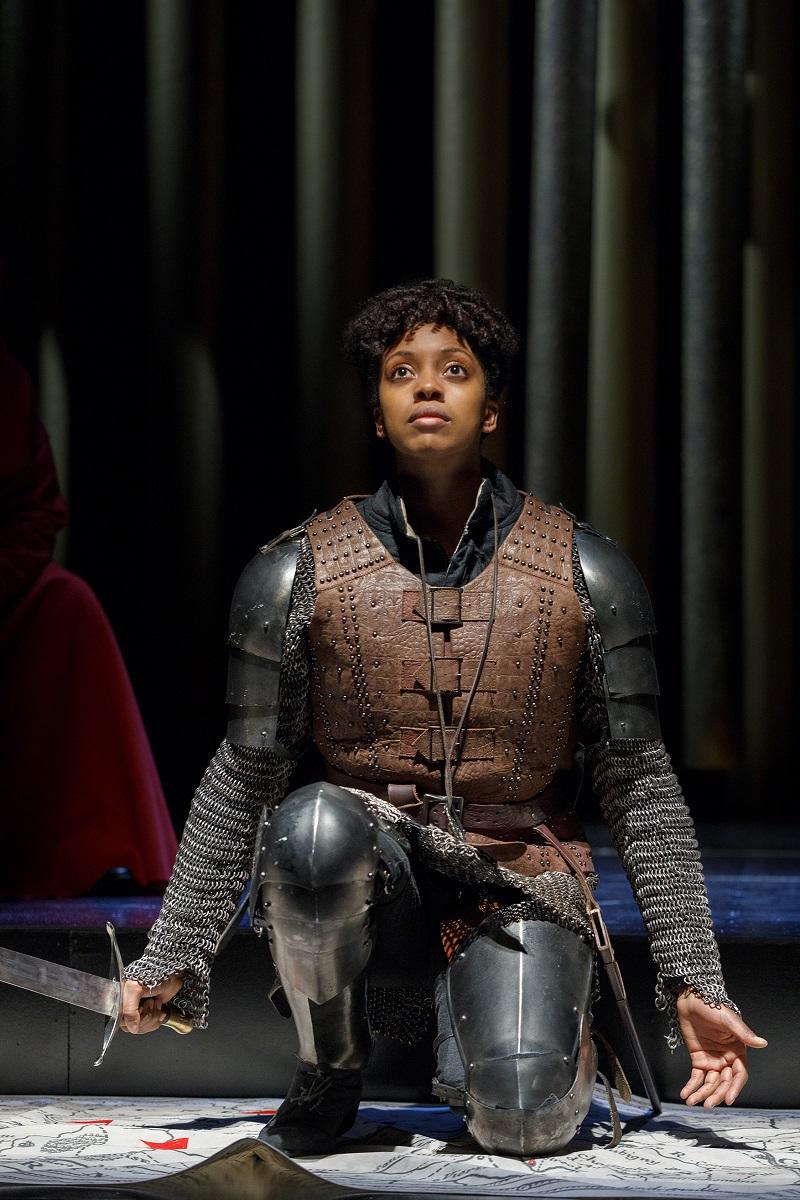
This earnest production might have worked better had the director taken a more adventurous approach to its staging. The ‘pipe organ’ set and the perfunctory ‘mood’ music didn’t really contribute to creating a suitably atmospheric frame for what turned out to be a very conventional piece of theatre: it looked and felt a bit like a high-school production, despite its ‘colour blind casting’ and a few fine performances by the actors. The text stages a series of debates between Saint Joan, the unlikely proto-feminist saviour of France and her patriarchal foils. Shaw’s language still packs a punch and conveys a complex set of ideas about the relationship between faith, politics and patriarchy. The cheesy period costumes and predictable blocking did little to enhance the dramatic text. The highlight, for me, was the epilogue where the characters who died during the course of the proceeding acts return to have an irreverent debate about their role in the drama. There’s a reason why this kind of wordy drama is rarely performed today. Still, it’s fascinating to see such a variety of theatrical genres rub shoulders on Broadway.
Sunday 6th May, LaMama
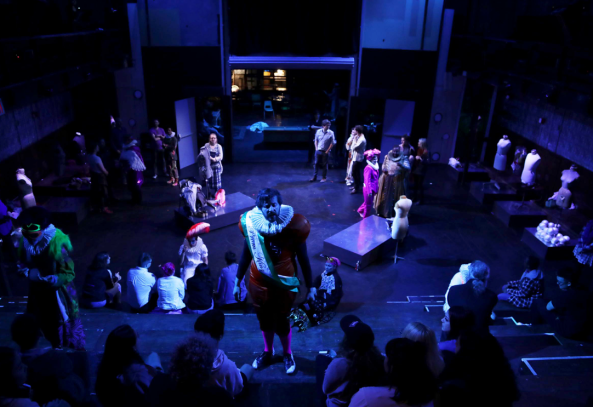
I didn’t expect much from this production since I was terminally bored by the two previous shows I’d seen at this theatre. I was not only pleasantly surprised by The Seagullmachine, but impressed by the scope of its ambition. The concept is simple: the work is a mash-up of two apparently incongruous plays, Checkov’s The Seagull, an exemplar of naturalism and Heiner Muller’s postmodern tour-de-force, The Hamletmachine. Both plays refer to Shakespeare’s Hamlet, but do so in very different ways. Muller’s references are deliberately overt while Chekov’s are oblique and subtle. The two plays also represent two end points on the spectrum of modern drama in Europe: Chekov’s work plays an important role in inaugurating the tradition while Muller announces its death, although Checkov’s work anticipates and dramatizes the debates about form and content that drive modernist innovation in the drama of the 20th century. The Seagullmachine joins the dots between these two points on the spectrum.
This production is a ‘twofer’: it stages both plays almost in their entirety. During the first half of the show we see a more or less conventional staging of The Seagull. The acting is naturalistic, but the house lights remain up, so members of the audience can see each other throughout the performance. I found the audience reactions as compelling as the play, and that’s not a putdown of the actors. They were great. However, it’s fascinating to watch how people are engaged (or disengaged) throughout a performance. The decision to eschew traditional stage lighting was brave, and it paid off by adding an extra layer of complexity to the actor/audience relationship. On a few occasions, the actors in The Seagull recite lines from Muller’s play. This creates a haunting effect. It as though Hamletmachine is knocking on The Seagull’s door, threatening to break it down, which of course it does after a strange cabaret interlude at the point of the suicide which concludes the Checkov text.
Then, the audience is moved into LaMama’s larger theatre space and the company perform The Hamletmachine. There is a bit of audience interaction, and the cast divide the audience into small groups and perform to this newly created subset. The play morphs from conventional naturalism to a wild postmodern barrage of noise and colour. Sound and fury signifying nothing? I don’t think so. This was a very compelling production that kept me engaged, and prompted me to think about the status of ‘experimental’ theatre. This was probably the best thing I saw during my short stay in NYC.
Schubert Theatre, Thursday 26th April.

Scratch that. 3 Tall Women rocks, Hello Dolly sucks. The lavish costumes, big, belting tunes and gaudy set could not disguise the fact that this production was a total crock. I guess you can’t expect a Broadway musical to offer much in the way of genuine dramatic tension, or intellectual interest. I knew this going in, and I don’t think my expectations were especially high. However, I was not prepared for the degree to which this frothy production bored the shit out of me. Moving closer to the stage after the interval gave me a closer view of the production values that make theatre tickets in this city so expensive. I must congratulate the design team on their attention to detail, yet, despite their efforts, I found it impossible for me to lose myself in this dreary tale about a matchmaker who attempts to find herself a man of her own. Bernadette Peters was appropriately sassy and irreverent and possessed the pipes to project herself far into the nose-bleed section of the Schubert theatre, but even her star talent couldn’t make me focus.
This creaky production certainly showed its age: it was written in a very different era when gender stereotypes remained sacrosanct and generated widespread guffaws. Perhaps the work may have been a bit more engaging had the director attempted to introduce a bit of irony to offset the dated and dreary ‘battle of the sexes’ scenario that lies at the heart of the staple. IN short, I couldn’t get lost in Yonkers.
Golden Theatre, Wednesday 18th April

Of course, I know Albee’s most famous plays, The Zoo Story and Whose Afraid of Virginia Woolf, but I’ve never bothered to acquaint myself with his oeuvre. Five minutes into 3 Tall Women, I felt vindicated in my decision to ignore this giant of the American theatre. The ‘drawing-room’ set reeked of the 19th century and the dialogue exchanged between the eponymous women barely held my attention, although seeing Glenda Jackson command the stage was probably worth the price of admission.
The set-up is apparently simple: we meet three women (A,B,C) at different stages of their lives. Jackson plays a wealthy, decrepit matriarch. She is confined to a wheel chair and has at 92 lost control of her bodily functions. She is cared for by a middle-aged woman, a 52-year-old paid worker compelled to clean up the piss and the shit and listen to the old lady rant and rave. The last member of the trio is a 26-year-old lawyer who is trying to make sure the old women’s legal papers are in order before she shuffles off this mortal coil. A man, the old crone’s estranged gay son, also appears, although he does not speak. Jackson has the lion share of the dialogue and makes the most of it, but even an actor of her stature struggles to transcend the limitations of the play’s staid dramatic structure.
The second act, however, is a revelation. The old Woman is represented by a mannequin, lying prostrate in bed. A, B and C are no longer distinct characters, but have all merged into A, albeit at different stages of A’s life. The younger self articulates her ambitions and has an open positive disposition towards her life. Her more mature manifestations admonish her for her naivety and each reflects on life from the perspective of their age. The play becomes more wistful and philosophical as it deals with the problem of age and time, and proffers competing theories about human happiness. The old dame has the last word, and, I think the most convincing argument: “That’s the happiest moment. When it’s all done. When we stop. When we can stop.” Jackson is superb, and the play demonstrated to me that we neglect the power of traditional scripted drama at our peril. Words do things. They do complex things, and there is no reason why we cannot be moved and mobilised by traditional, commercial theatre as by downtown experimentation. The downtown shows I’ve seen so far have been very disappointing. Broadway, on the other hand, rocks!
Walter Kerr Theatre, Tuesday 17th April 8.00pm

I didn’t expect to see this show. Tickets are very expensive, and the entire run was sold out months ago. On a whim, I used a slightly dodgy third-party vendor to secure a seat at the Walter Kerr theatre. Thank you, Linda Lawson, for making your very expensive purchase available.
The Boss did not disappoint. He delivered the excerpts from his autobiography with flair, confidence and showmanship. He proved to be an adept performer with a great sense of comic timing when appropriate. The piece covers his often-fraught relationship with his parents and bandmates and uses a more or less chronological arc to reflect on his life: from the self-deprecating stories about his early ambitions to anecdotes that deflate the mythology of his ‘born-to-run’ persona to the tragedy of experiencing the loss of close friends and confidants as time passes, Bruce proves to be a compelling raconteur. Armed with an acoustic guitar and grand piano, Bruce plays a selection of his most autobiographical songs, which reinforce the connections between his life and his art. The strip-backed songs shine like rough diamonds in the intimate space, which is small enough for Bruce to go off-mic and still be heard clearly.
The space and the subtle lighting effects provide a subtle setting for the performance, which, while theatrical, never becomes overly earnest or artificial. The highlight for me was ‘Born in the USA’, a much-misunderstood song that mixes anger with pride, politics with passion and patriotism with despair. Bruce turns up the volume, and rocks out with an open-tuned slide guitar accompaniment that highlights the song’s emotional and political ambiguities. He’s also perfected the art of speaking while providing an atmospheric accompaniment on whatever instrument he happens to be playing, he often let his noodling set the mood for his stories.
The audience were obviously enthralled, and I felt moved by the way this superstar celebrity opens himself up on stage, giving his fans a glimpse of his fragility, his vulnerability, his foibles, but most of all, his humanity.
American Airlines Theatre, Wednesday March 11, 2.00pm
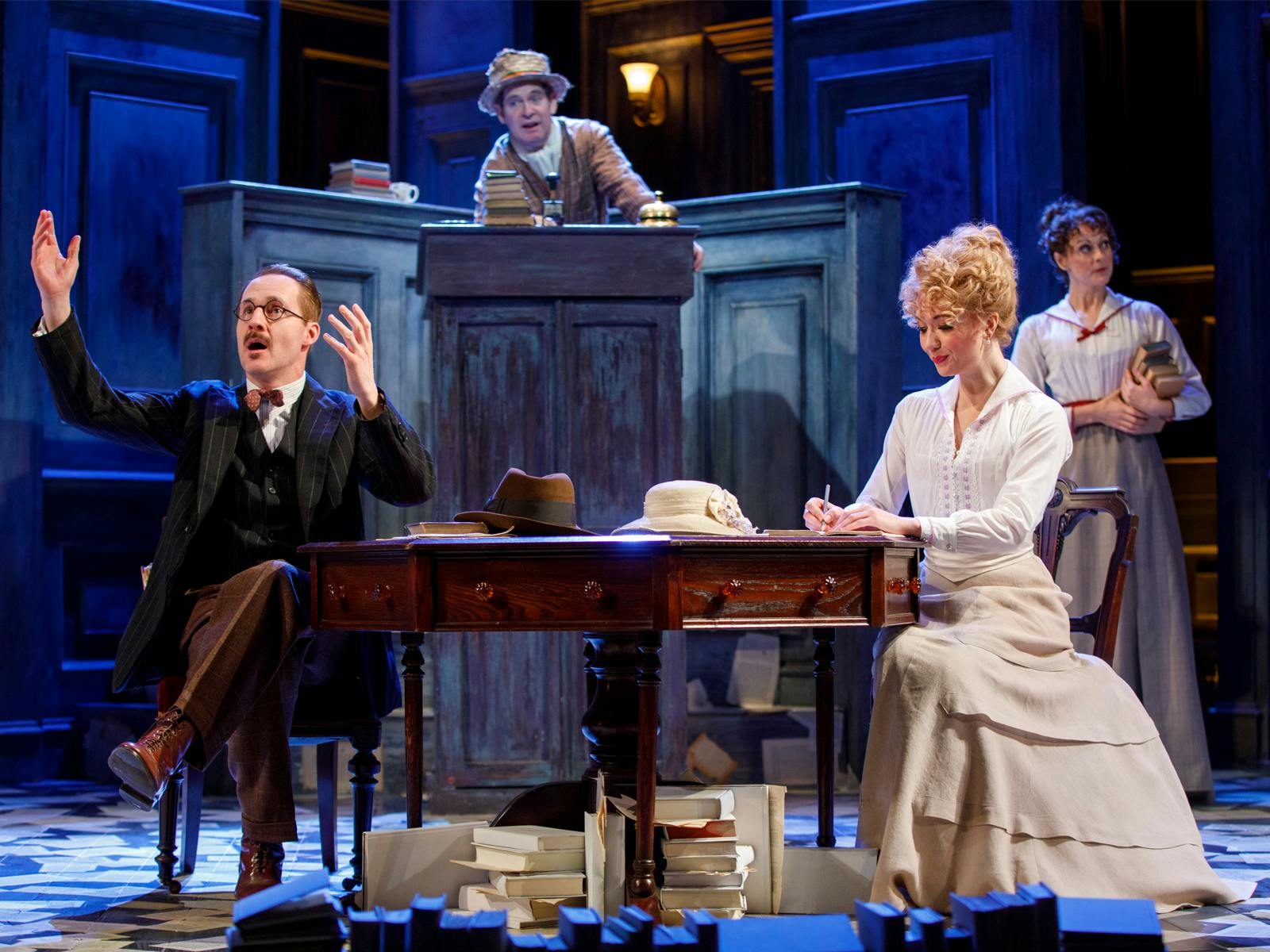
The set was beautiful and the actors didn’t miss a beat, but there was something oddly archaic about this production despite Stoppard’s witty writing and still relevant observations about the relationships between art and politics. Perhaps it was the grandeur of the half-empty theatre, or the predominantly grey-haired audience but the play’s form, which I once experienced as innovative, seemed so old-fashioned, which is not surprising given that the play is around 45 years old.
The conceit remains compelling: an old man, Car, a minor official in the British consulate in Zurich, unreliably recalls an incident from the dim, distant past involving Tzara, Joyce and Lenin and a production of The Importance of Being Earnest in which he starred. The 3 important historical personages apparently all lived in Zurich during the time before the Russian revolution, and Stoppard uses this odd coincidence to interrogate various aesthetic and political theories: is art merely an elitist bourgeois practice that inflates its own sense of importance? Is the artist a charlatan or genius? Does chance and circumstance have as much to do with artistic creation as skill and craft? In short, is the whole aesthetic enterprise a mere travesty?
I’ve always wanted to see the play on stage in order to see how Stoppard’s approach to representing the fallibility of human memory works on stage (he repeats scenarios with key variations in language, accent and power relations). The production executed this aspect of the text clearly, and I felt engaged throughout the performance. However, I left the theatre with the overwhelming impression that I’d just witnessed a lecture on aesthetics. A complex, witty and deeply thoughtful lecture, but a lecture nonetheless. Not that there’s anything wrong with that.